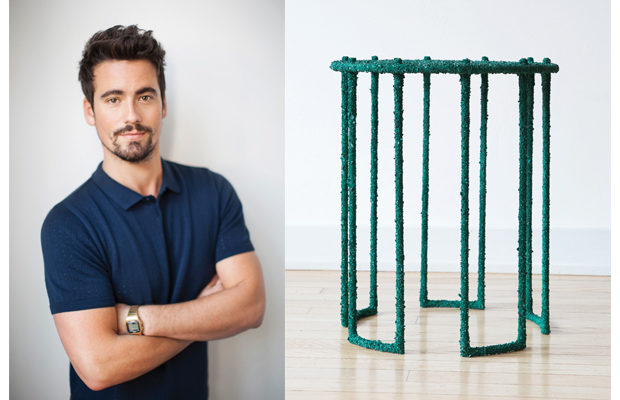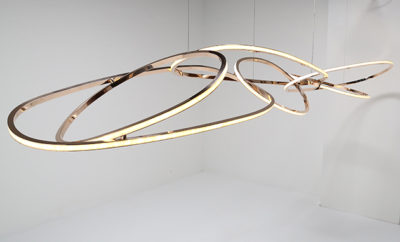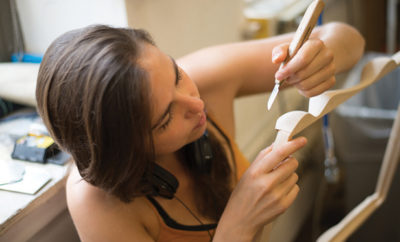 SAMUEL AMOIA | Side table of crushed malachite from the Democratic Republic of the Congo.
SAMUEL AMOIA | Side table of crushed malachite from the Democratic Republic of the Congo. All photos by Eileen Chaing.
Design
The Crystal Method
DESIGNER SAMUEL AMOIA CRAFTS A GLITTERING NEW COLLECTION FOR DELORENZO GALLERY
ON A RECENT AFTERNOON the scene inside designer Samuel Amoia’s bright Long Island City studio was one of orderly commotion. Two assistants, donning respirators, pressed dusty bits of lapis lazuli onto the underside of a round coffee table, taking breaks to pulverize larger chunks into particles the size of fish-tank gravel. Amoia, dressed in Nike sneakers, tapered sweats, and a snug white T-shirt, grabbed a handful of the crushed stones and ran them underneath a faucet to demonstrate the desired visual effect: “The color explodes,” he says admiringly of the resulting spectrum of china and cerulean blues.
The mineral-encrusted coffee table is part of a ten-piece collection Amoia has designed for DeLorenzo Gallery, a dealer known for its impeccable holdings of twentieth-century decorative arts that include works by Eileen Gray, Frank Lloyd Wright, and Alexandre Noll. Amoia will be the first living designer from whom the gallery has commissioned work, marking a new chapter for both the burgeoning interior designer and the Manhattan gallery. “He is adventurous,” gallery director Adriana Friedman says of Amoia. “His work spoke to me like Jean-Michel Frank’s did—things that could be timeless.”
While Amoia knew he wanted to pursue design, his career path meandered. After a stint modeling, he turned to hospitality, serving as a manager at various André Balazs properties, including the Mercer and the Standard in New York. A serendipitous run-in with celebrated interior designer Stephen Sills changed all that. To Amoia’s surprise, Sills offered him a job. “I was really the luckiest person in the world,” he says. Under Sills’s tutelage, Amoia flourished. And eventually, with his mentor’s blessing, he established his eponymous firm, Samuel Amoia Associates, in 2012. He went on to design high-end residential and commercial interiors throughout the United States and Central America, including a chic gym for Stephen Cheuk’s S10 Training in TriBeCa; an eco-inspired penthouse for 1 Hotel & Homes in Miami Beach; and a series of lagoon cottages for the Itz’ana Resort and Residences in Belize. During such projects, he began his first forays into custom furnishings.

Console with brass shavings and white Italian onyx top.
“Jean-Michel Frank, Les Lalanne, Jean Royére, Eileen Gray—they are the masters of design because the work shows so much restraint,” Amoia says. “I was interested in doing work like that, but using materials that were not necessarily luxurious.” He started investigating materials that were perhaps better suited to a garage than a gallery: cement, gypsum, plaster, and rock salt. With sculptor Fernando Mastrangelo, he established AMMA Studio, where he created objects caked in pink Himalayan salt and black silica. The work gained a cult following of elite clientele, including Stella McCartney and Jenna Lyons. The AMMA partnership dissolved, but Amoia continued to pursue object making. For the Itz’ana project (named after the Mayan deity of day and night), he unveiled a rustic home collection inspired by French art deco and Central American craft, made from locally sourced palo blanco wood. His latest endeavor, Amoia Studio, which he founded with his brother Dominic last fall, is a furniture-focused offshoot of his interior design practice. In a recent capsule collection for Dover Street Market, the purveyor of high-end avant-garde fashions, they developed a set of ten plaster drums embedded with semi-precious stones; the resulting material is a sort of shamanic terrazzo.
Last year Amoia was tapped by Friedman to design DeLorenzo’s new interiors on Madison Avenue. Unbeknownst to Amoia, Friedman was also looking to commission a collection from a contemporary artist and had an assistant cull images from a variety of emerging designers. During a meeting with Amoia, Friedman recalls, “He said ‘Let me show you what I also do,’ and he pulls out the only table I had pulled out from the stack!” She laughs: “It was meant to be.”

In a collaboration with Dover Street Market, Samuel Amoia created the Mineral Terrazzo series, a collection of ten drums made of fifteen different mineral rocks from Brazil mixed with cream plaster.
Together with gallery founder Anthony DeLorenzo, they began envisioning the collection. Friedman says, “I wanted a storyline that was very much in the spirit of what he had been making.” Back in Amoia’s Long Island City studio (he is using it part-time to fabricate this collection; his main studio is in Greenpoint, Brooklyn) the collection was nearly complete. Downstairs, a photographer shot the latest gleaming additions—a curvaceous red-jasper table, legs as delicate as croquet wickets, and a bean-shaped coffee table and matching console, both topped with milky slabs of white onyx. “A lot of my stuff is masculine and bold.” Amoia explains as he observes the shoot. “This is more feminine and fluid.” But the pieces still maintain an edge; the reed-thin legs of the console and coffee table are coated in needle-sharp brass shavings. Nearby, a drum prototype—covered in an abstract pattern of clay—sat ready to be cast in heavy brass.

Side table of black tourmaline from India and black cement plaster.
Amoia considers this recent work to be his best. The industry agrees: this year, Maison & Objet awarded Amoia with a Rising American Talent award. The pace is only picking up: in addition to this series, Amoia is working on a collection of the drums for retailer AHAlife, pursuing a lighting and accessories line, and is in talks to do an interior design television show. In the studio a pyrite-covered console table commissioned by Peter Marino was en route to a Dior boutique in London. To boot, Amoia is now working on a new set of villas for the Itz’ana Resort and a to-be-announced residential project in Berlin. Fortunately, he says, “I do my best work on an airplane.”












